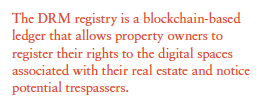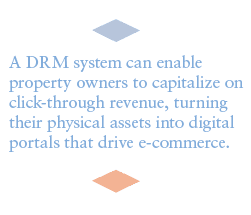The growing convergence of digital and physical worlds is reshaping the landscape of real estate, introducing complex new challenges in managing both tangible assets and their digital interface.
In recent years, the rapid growth of augmented reality (AR) and extended reality (XR) ecosystems has been fueled by breakthroughs in both hardware—such as AR glasses and smartphones—and software, including immersive apps, interactive games, and digital advertising. These technologies are poised to revolutionize sectors like entertainment, real estate, advertising, and tourism by blending digital content seamlessly with the physical world.
While this innovation opens up exciting new possibilities for engagement, it also brings with it significant challenges, particularly around property rights.
For instance, unauthorized AR advertisements projected onto buildings or virtual objects anchored to real-world locations without consent could infringe upon property owners’ rights. In a world where the line between digital and physical spaces is becoming increasingly blurred, property owners will find themselves navigating not just the physical space they control but also the rights and interactions that unfold in digital environments. They risk losing control over how their assets are used, represented, and even monetized.
Without a clear framework to govern these digital interactions, the potential for exploitation and conflict grows—leaving property owners vulnerable to unintended or unauthorized use of their physical and virtual spaces.
To stay ahead, property owners must develop new systems that not only safeguard their intellectual and physical assets, but also verify and track digital interactions tied to their properties. By implementing such systems, they can maintain authority over how their properties are represented and utilized by AR, ensuring that both the real and virtual dimensions of their assets are protected and commercialized.
INTRODUCTION TO DIGITAL MEDIA RIGHTS

Digital Media Rights (DMR) represent a new category of intellectual property that extends traditional real estate rights into the digital universe. Historically, property rights have been limited to the physical land, buildings, and air rights associated with a property. However, as augmented reality (AR) and extended reality (XR) technologies evolve, digital content is increasingly interacting with and overlaying real-world physical spaces. Property owners now face the challenge of managing their physical assets as well as the digital interactions associated with them.
Currently, there is no standardized system for managing the rights to digital content in real-world spaces. As a result, many property owners are unaware that their buildings, landscapes, or public areas are being used for AR content without their permission. This represents a significant gap in both property law and the digital economy. The rapid growth of AR technology has created a new frontier for intellectual property rights: one that requires careful consideration and the development of appropriate legal and technological framework.
CURRENT USES OF DRM IN THE MEDIA INDUSTRY
Digital Rights Management (DRM) systems have long been used in the media industry to protect and monetize intellectual property. The evolution of digital content—from music and films to video games and e-books—has necessitated the development of systems that ensure creators are compensated for the use of their work and that unauthorized duplication or distribution is prevented.
Legal Precedents Protecting Real Estate as Intellectual Property
Like any other form of intellectual property, real estate is protected by a wide array of legal precedents that govern how it can be used, leased, or monetized. Traditionally, property rights have been limited to the physical boundaries of a property—its land, buildings, and the space immediately surrounding it. However, as augmented reality (AR) and other digital technologies increasingly intersect with the physical world, property owners must contend with new challenges related to the use of their assets in digital spaces.
The legal precedents governing real estate as intellectual property are rooted in several key legal frameworks, including air rights, trespassing laws, and the Lanham Act (detailed below). These precedents provide the foundation for extending property rights into the digital realm, where unauthorized use of a property in AR or digital environments can infringe upon a property owner’s rights.

Air Rights: Controlling the Space Above Property
One of the most established legal frameworks for protecting real estate as intellectual property is the concept of air rights, or the property owner’s legal right to control, lease, or sell the space above their land. These rights are particularly valuable in urban environments, where developers often seek to build vertically, using the airspace above existing structures. Property owners can sell their air rights to developers, allowing them to build taller buildings while compensating the original owner for the use of the transferred space.
Air rights illustrate the principle that property ownership extends beyond the physical boundaries of the land itself. Just as property owners can sell or lease the space above their land, they should also have the right to control the digital spaces associated with their assets. In an AR environment, this could include the space where virtual objects, advertisements, or experiences are projected onto a building or property.
Trespassing Laws: Preventing Unauthorized Digital Use
Another important legal framework for protecting real estate is trespassing law. Trespassing occurs when someone enters or uses another person’s property without permission. While traditionally focused on physical intrusions, trespassing laws can also apply to unauthorized digital interactions with real estate.
In the context of AR, digital trespassing occurs when virtual content is projected onto a property without the owner’s consent. This could include an AR game that uses a private property for part of its gameplay, or an AR advertisement projected onto a building without permission.
Several legal cases have addressed the issue of trespassing in digital environments. For example, in Pokémon Go, a mobile AR game that placed virtual creatures and objects on real-world properties, several lawsuits were filed by property owners who claimed that the game encouraged players to trespass on their land. These cases highlighted the need for clear legal protections against unauthorized digital use of real estate.
The Lanham Act: Protecting Property in Commercial Use
The Lanham Act, which governs trademark law in the United States, provides additional protections for property owners in the context of commercial use. The Act prohibits the use of a property’s image in a way that could confuse consumers or falsely suggest that the property owner endorses a particular product or service. This is particularly relevant in the context of AR, where advertisements or branded content could be projected onto a specific building without the owner’s permission, leading consumers to believe that the property owner has endorsed the product being advertised.
Several landmark cases have reinforced the importance of protecting property owners from unauthorized commercial use. For example, in Landmark Communications v. FCC, the court ruled that a company could not use the image of a well-known building in an advertisement without the permission of the property owner. Similarly, in Architectural Copyright Protection v. XYZ, property owners successfully argued that their buildings, as unique and recognizable architectural works, were protected under copyright law.
These legal precedents demonstrate that property owners have the right to control how their assets are used in both physical and digital environments. By ensuring that property owners can approve or deny the use of their properties in AR advertisements, games, or experiences.
DIGITAL MEDIA RIGHTS REGISTRY
At the heart of the DMR management system is the DMR Registry, a blockchain-based ledger that allows property owners to register their rights to the digital spaces associated with their real estate and notice potential trespassers.

This registry will function as a public, immutable record of ownership, ensuring that property owners retain control over if and how their assets are used in AR environments.
When a property owner registers their rights in the system, they will define the digital boundaries of their property—both horizontally and vertically. This will include the façade of a building, the airspace above it, and any other areas where AR content might be projected or anchored. By registering their rights, property owners will defend their ability to approve, deny, or monetize digital content associated with their assets.
The use of blockchain technology ensures that these rights are secure and tamper-proof. Once a property owner registers their DMR, the record cannot be altered without their consent, providing a robust legal framework for enforcing these rights in the digital world.
Smart Contracts for Licensing Digital Media Rights
To facilitate licensing of digital media rights, the DRM system will utilize smart contracts. Smart contracts are self-executing agreements that automatically enforce the terms of a contract when certain conditions are met. In the context of the DRM system, smart contracts will be used to handle transactions between property owners and licensees, such as advertisers or AR content developers.
For example, an advertiser might wish to project an AR advertisement onto the side of a building for a specific period of time. The property owner can create a smart contract that outlines the terms of the agreement, including the duration of the advertisement, the compensation the owner will receive, and any restrictions on the type of content that can be displayed. Once the contract is signed by both parties, it is recorded on the blockchain via the DRM system and automatically enforced. If the terms of the agreement are violated, the contract will trigger penalties or terminate the agreement.
Smart contracts provide a streamlined and secure way to manage digital media rights, ensuring that property owners are compensated fairly and that advertisers and developers can easily obtain the necessary permissions to use digital spaces.
The Need for an Ethical Marketplace for Media and Tech Companies
As the digital economy continues to evolve, particularly with the rise of AR technologies, the need for a transparent and ethical marketplace to manage digital media rights is becoming increasingly urgent.
Tech companies such as Meta (formerly Facebook), Google, and Snapchat are heavily investing in AR, with Meta leading the charge toward an immersive metaverse that blends physical and digital worlds. These platforms are dependent on advertising revenue, with Meta deriving more than 98% of its revenue from ads. As AR ads begin to play a larger role in the advertising landscape, companies will need a structured system to ensure that the use of digital space on physical assets is both ethical and legal.
CLICK-THROUGH REVENUE AND AFFILIATE MONETIZATION
One of the most significant opportunities created by the integration of AR into real-world environments is the potential for click-through revenue and affiliate monetization. As AR ads become more interactive and personalized, property owners can generate additional revenue by facilitating digital interactions that lead to online purchases. A DRM system can enable property owners to capitalize on click-through revenue, turning their physical assets into digital portals that drive e-commerce.
How Click-Through Revenue Works in AR
In traditional online advertising, click-through revenue is generated when a user clicks on an advertisement and is directed to a product or service page. If the user makes a purchase, the website or platform that hosted the ad receives a commission or affiliate fee. This model has proven highly successful in the online retail world, with platforms like Google, Instagram, and Amazon benefiting from affiliate marketing programs, generating billions of dollars in annual revenue worldwide.
In the context of AR, buildings and other real-world properties can function as digital billboards, hosting interactive, personalized ads that users engage with through AR devices. For example, a brand might project an AR ad onto the side of a prominent building in a busy shopping district. A user wearing AR glasses could interact with the ad by clicking on the product displayed, which would take them directly to the brand’s website, where they could make a purchase.
By integrating click-through revenue into the DRM system, property owners can earn a percentage of the sales generated through these AR interactions. Just as websites earn affiliate revenue from driving traffic to e-commerce platforms, property owners can earn affiliate commissions for facilitating AR ads that lead to online purchases. This creates a new revenue stream for real estate owners, turning their buildings into digital portals that connect users with brands and products.
The Future of Insurance in AR: Evolving with Technology
As AR technologies become more widespread and complex, insurance companies will need to adapt to the new risks presented by this evolving digital landscape. Once insurance companies fully understand the implications of AR content being displayed on real-world assets, they will likely refuse to pay claims unless there is clear proof that the proper liability protections were in place.
This means that, in the future, property owners and individuals will be required to obtain additional protections from any entity that wants to use their digital spaces to display AR media. Insurance companies will view the use of AR as a high-risk activity unless they see that the content creators have provided proper indemnification through the DRM system.
BUILDING A VERIFIED AND INSURED AR ECOSYSTEM
The rise of AR marks a transformational moment for how we interact with the world around us. As physical spaces, people, and objects become conduits for digital media, the need for a robust DRM system becomes essential. By establishing a secure, transparent, and permission-based framework for managing digital media rights property owners, individuals, and businesses can maintain control over how their assets are used in AR environments.
Through the DRM system, property owners and individuals can verify their identity and assets in the 3D internet, providing a “blue checkmark” of authenticity and ownership. This verification is critical to preventing misuse, fraud, and unauthorized digital content projection onto real-world spaces. In this new AR-enabled economy, accurately and securely managing one’s digital presence will be as important as managing physical assets. Individuals and businesses will benefit from full control over their digital identity, ensuring that every AR interaction is tied to a verified, authorized entity.
Moreover, the DRM system addresses the complex issue of insurance and liability. In AR environments, where buildings, individuals, and objects can act as distribution points for digital content, liability concerns are as real as in physical contexts. Just as property owners today require insurance for movie shoots or commercial activities on their land, the DRM platform will require content creators and advertisers to provide liability coverage before projecting AR content onto a person, place, or thing. By baking insurance into the system, we ensure that every digital interaction is legally protected and that all parties are shielded from the financial risks associated with liability claims.
A comprehensive DRM system also supports the long-term sustainability of the AR economy. It empowers property owners and individuals to monetize their digital spaces, while protecting them from legal and financial risks. At the same time, it provides advertisers, tech companies, and content creators with a transparent and ethical framework for using digital spaces in the 3D internet.
Implementing the DRM system sets the stage for a resilient, verifiable, and fully insured AR ecosystem. This framework not only embraces the core principles of Web 3—prioritizing true ownership and data integrity—but also ensures that the AR economy is underpinned by transparency, trust, and robust legal compliance. As AR technology continues to evolve, the DRM platform will become an essential tool for managing the growing complexities of the digital landscape. It will safeguard property rights, personal identities, and digital media interactions, ensuring they are secure, monetizable, and protected in an increasingly interconnected world.
Property owners of all types face continued headwinds from volatile occupancy rates, inflationary pressures on operating costs, increased regulation and property taxes, and other factors that challenge traditional NOI.
They will need to continue to innovate, exploring new ways to unlock value and identify new revenue streams. One new promising avenue is through Digital Media Rights (DMRs), an emerging concept that mirrors assets such as air, water, and mineral rights, which exist “adjacent” to the physical building itself.
DMRs are an intriguing way for building owners and operators to monetize the emerging digital realm of the 3D spatial Internet, accessible via personal devices and, increasingly, augmented reality (AR) glasses.
Buildings are the intellectual property of our industry and deserve the same level of protection and commercialization as other forms of IP. Allowing content providers to serve ads tagged to specific buildings should require our consent and participation in the revenue streams. Moreover, such activity exposes property owners to liability, further supporting control of an asset’s digital space.
The global digital advertising market has been estimated to be worth over $360 billion in the US in 2025. A significant portion of this activity will continue migrating to the built environment. Critically important to the real estate industry is the establishment of a platform that tracks digital activity in and around buildings, ensuring that operators and owners can unlock and safeguard the financial interests to which they are entitled.
NEW: SUMMIT #17

+ EDITOR’S NOTE
+ ALL ARTICLES
+ PAST ISSUES
+ LEADERSHIP
+ POLICIES
+ GUIDELINES
+ MEDIA KIT
+ CONTACT
WHERE ARE WE IN THE CYCLE?: OVERVIEW OF THE US ECONOMY AND REAL ESTATE SECTOR
Richard Barkham + Jacob Cottrell | CBRE
COMPELLING OPPORTUNITIES: MAKING A CASE FOR US REAL ESTATE
Karen Martinus + Mark Fitzgerald + Max von Below | Affinius Capital
OPEN WINDOW: WHY NOW IS THE TIME TO INVEST IN COMMERCIAL REAL ESTATE
Chad Tredway + Josh Myerberg + Luigi Cerreta | JPMAM
NORMALIZING MOVEMENT: POPULATION MOVEMENTS NORMALIZING AFTER COVID-19 SHOCK
Martha Peyton + Matthew Soffair | LGIM America
CHRONIC SHORTAGE: THE US HOUSING SCARCITY WILL BE LIKELY TO PERSIST FOR SEVERAL YEARS
Gleb Nechayev | Berkshire Residential Investments
FLORIDA FOCUS: PRODUCTION INDEX BELOW 50 CURIOUSLY SIGNALS OPPORTUNITY
Rafael Aregger | Empira Group
WHOLESALE CHANGE: DEMOGRAPHIC CHANGES AND STAGNANT INVENTORY CREATE NEW OPPORTUNITIES FOR RETAIL
Stewart Rubin + Dakota Firenze | New York Life Real Estate Investors
GAME CHANGE: INFRASTRUCTURE GROWTH ACCELERATING WITH AI
Jon Treitel | CBRE Investment Management
FOR THE TREES: MASS TIMBER INTEGRATION IN INDUSTRIAL REAL ESTATE
Mary Ellen Aronow + Erin Patterson + Caroline Suarez + Cassidy Toth | Manulife Investment Management
BORDER INDUSTRIAL: INVESTING IN US/MEXICO BORDER PORT INDUSTRIAL MARKETS
Dags Chen, CFA + Lincoln Janes, CFA | Barings Real Estate
RESILIENCE AMIDST UNCERTAINTY: HOW ISRAELI AND UKRAINIAN INVESTORS ARE ADAPTING REAL ESTATE STRATEGIES DURING CONFLICT
Asaf Rosenheim | Profimex
CYBER RISK VIGILANCE: HOW REAL ESTATE DIRECTORS AND BOARDS CAN GUARD AGAINST CYBER RISK
Marie-Noëlle Brisson, FRICS, MAI + Michael Savoie, PhD | CyberReady, LLC
ALTERNATE REALTY: DIGITAL RIGHTS MANAGEMENT FOR REAL ESTATE AND AUGMENTED REALITY
Neil Mandt | Digital Rights Management + Steve Weikal | MIT Center for Real Estate
DRIVING FORCE: UNDERSTANDING SYNDICATED LOANS AND MULTI-TIERED FINANCING
Gary A. Goodman + Gregory Fennell + Jon E. Linder | Dentons
HOUSING COMPLEX: CUTTING-EDGE APARTMENTS ARE A CATALYST FOR A MORE PROFITABLE FUTURE
Alejandro Dabdoub | AOG Living

NOTES
[]
ABOUT THE AUTHORS
Neil Mandt is Founder & CEO of Digital Rights Management. Steve Weikal is Industry Chair, Real Estate Transformation Lab, MIT Center for Real Estate.
THIS ISSUE OF SUMMIT JOURNAL IS GENEROUSLY SPONSORED BY
/ EXECUTIVE SPONSOR

AOG Living is a leading fully integrated, multifamily real estate investment, construction, and property management firm headquartered in Houston, Texas. AOG Living has acquired, built, or developed more than 20,000 multifamily units with a total aggregate value of over $2.4 billion and has a growing portfolio of more than 35,000 apartment homes and 170+ properties under management throughout the nation. Learn more at aogliving.com.
Vertically integrated owner, operator, and developer of Sunbelt multifamily. Partnering with institutions on a single-asset and programmatic basis. 28k+ units acquired and developed. 62k+ units under management. 1,500+ associates. 8 Sunbelt states. To learn more, visit hrpinvestments.com and hrpliving.com. And for more information, contact john.duckett@hrpliving.com.
Affinius Capital is an integrated institutional real estate investment firm focused on value-creation and income generation. With a 40-year track record and $64 billion in gross assets under management, Affinius has a diversified portfolio across North America and Europe providing both equity and credit to its trusted partners and on behalf of its institutional clients globally. To learn more, visit affiniuscapital.com.



